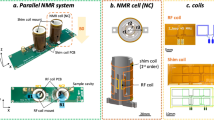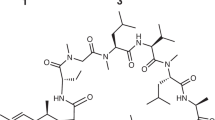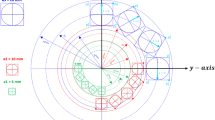Abstract
The development of powerful sensors for the detection of weak electromagnetic fields is crucial for many spectroscopic applications, in particular for nuclear magnetic resonance (NMR). Here, we present a comprehensive theoretical model for boosting the NMR signal-to-noise ratio, validated by liquid-state 1H, 129Xe and 6Li NMR experiments at low frequencies, using an external resonator with a high quality-factor combined with a low-quality-factor input coil. In addition to an enhanced signal-to-noise ratio, this approach exhibits striking features such as a high degree of flexibility with respect to input coil parameters and a square-root dependence on the sample volume, and signifies an important step towards compact NMR spectroscopy at low frequencies with small and large coils.
This is a preview of subscription content, access via your institution
Access options
Subscribe to this journal
Receive 12 print issues and online access
$209.00 per year
only $17.42 per issue
Buy this article
- Purchase on Springer Link
- Instant access to full article PDF
Prices may be subject to local taxes which are calculated during checkout




Similar content being viewed by others
References
Abragam, A. The Principles of Nuclear Magnetism (Clarendon, 1961).
Ernst, R. R., Bodenhausen, G. & Wokaun, A. Principles of Nuclear Magnetic Resonance in One and Two Dimensions (Clarendon, 1987).
Hoult, D. I. & Richards, R. E. The signal-to-noise ratio of the nuclear magnetic resonance experiment. J. Magn. Reson. 24, 71–85 (1976).
Webb, A. G. Radiofrequency microcoils in magnetic resonance. Prog. Nucl. Magn. Reson. Spectrosc. 31, 1–42 (1997).
Sillerud, L. O. et al. 1H NMR detection of superparamagnetic nanoparticles using a microcoil and novel tuning circuit. J. Magn. Reson. 181, 181–190 (2006).
Coffey, A. M., Truong, M. L. & Chekmenev, E. Y. Low-field MRI can be more sensitive than high-field MRI. J. Magn. Reson. 237, 169–174 (2013).
Greenberg, Y. S. Application of superconducting quantum interference devices to nuclear magnetic resonance. Rev. Mod. Phys. 70, 175–222 (1998).
McDermott, R. et al. Liquid-state NMR and scalar couplings in microtesla magnetic fields. Science 295, 2247–2249 (2002).
Kominis, I. K., Kornack, T. W., Allred, J. C. & Romalis, M. V. A subfemtotesla multichannel atomic magnetometer. Nature 422, 596–599 (2003).
Sheng, D., Li, S., Dural, N. & Romalis, M. V. Subfemtotesla scalar atomic magnetometry using multipass cells. Phys. Rev. Lett. 110, 160802 (2013).
Staudacher, T. et al. Nuclear magnetic resonance spectroscopy on a (5-nanometer)3 sample volume. Science 339, 561–563 (2013).
Jelezko, F. et al. Observation of coherent oscillation of a single nuclear spin and realization of a two-qubit conditional quantum gate. Phys. Rev. Lett. 93, 130501 (2004).
Appelt, S., Häsing, F. W., Kühn, H., Perlo, J. & Blümich, B. Mobile high resolution xenon nuclear magnetic resonance spectroscopy in the Earth’s magnetic field. Phys. Rev. Lett. 94, 197602 (2005).
Theis, T. et al. Parahydrogen-enhanced zero-field nuclear magnetic resonance. Nature Phys. 7, 571–575 (2011).
Ledbetter, M. P. et al. Near-zero field nuclear magnetic resonance. Phys. Rev. Lett. 107, 107601 (2011).
Happer, W. Optical pumping. Rev. Mod. Phys. 44, 169–249 (1972).
Bouchiat, M. A., Carver, R. R. & Varnum, C. M. Nuclear polarisation in He3 gas induced by optical pumping and dipolar exchange. Phys. Rev. Lett. 5, 373–375 (1960).
Carver, T. R. & Slichter, C. P. Experimental verification of the Overhauser nuclear polarization effect. Phys. Rev. 102, 975–981 (1956).
Bowers, C. R. & Weitekamp, D. P. Transformation of symmetrization order to nuclear-spin magnetisation by chemical reaction and nuclear magnetic resonance. Phys. Rev. Lett. 57, 2645–2648 (1986).
Adams, R. W. et al. Reversible interactions with para-hydrogen enhance NMR sensitivity by polarization transfer. Science 323, 1708–1711 (2009).
Perlo, J. et al. High-resolution NMR spectroscopy with a portable single-sided sensor. Science 308, 1279 (2005).
Blümich, B., Casanova, F. & Appelt, S. NMR at low magnetic fields. Chem. Phys. Lett. 477, 231–240 (2009).
Appelt, S., Kühn, H., Häsing, F. W. & Blümich, B. Chemical analysis by ultrahigh-resolution nuclear magnetic resonance in the Earth’s magnetic field. Nature Phys. 2, 105–109 (2006).
Sleator, T., Hahn, E. L., Hilbert, C. & Clarke, J. Nuclear spin noise. Phys. Rev. Lett. 55, 1742–1745 (1985).
Mamin, H. J., Budakian, R., Chui, B. W. & Rugar, D. Magnetic resonance force microscopy of nuclear spins: Detection and manipulation of statistical polarization. Phys. Rev. B 72, 024413 (2005).
Sun, N. et al. Small NMR biomolecular sensors. Solid-State Electron. 84, 13–21 (2013).
Augath, M., Heiler, P., Kirsch, S. & Schad, L. R. In vivo39K, 23Na and 1H MR imaging using a triple resonant RF coil setup. J. Magn. Reson. 200, 134–136 (2009).
Gleich, B. & Weizenecker, J. Tomographic imaging using the nonlinear response of magnetic particles. Nature 435, 1214–1217 (2005).
Wäckerle, G., Appelt, S. & Mehring, M. Two-dimensional optical spectroscopy by periodic excitation of sublevel coherence with sub-Doppler resolution. Phys. Rev. A 43, 242–250 (1991).
Appelt, S., Waeckerle, G. & Mehring, M. in High Precision Navigation 95 (eds Linkwitz, K. & Hangleiter, U.) 29–36 (Dümmler Verlag, 1995).
Staiber, H-D., Appelt, S., Butscher, R., Wäckerle, G. & Mehring, M. in High Precision Navigation 95 (eds Linkwitz, K. & Hangleiter, U.) 62–69 (Dümmler Verlag, 1995).
Tullney, K. et al. Constraints on spin-dependent short-range interaction between nucleons. Phys. Rev. Lett. 111, 100801 (2013).
Engelke, F. Virtual photons in magnetic resonance. Concepts Magn. Reson. 36A, 266–339 (2010).
Halbach, K. Design of permanent multipole magnets with oriented rare earth cobalt material. Nucl. Instrum. Methods 169, 1–10 (1980).
Driehuys, B. et al. High-volume production of laser-polarised 129Xe. Appl. Phys. Lett. 69, 1668–1670 (1996).
Acknowledgements
The authors gratefully acknowledge excellent technical assistance and financial support from S. van Waasen, R. Eichel and A. Schwaitzer at Forschungszentrum Jülich GmbH, and P. Schleker at RWTH Aachen University for sample preparation and consistency checks. We also wish to thank W. Zia for stimulating discussions, as well as J. Colell, M. Emondts and S. Glöggler for their help with various details in hardware construction. Furthermore, we would like to thank M. J. Blümich and H. Burlet for editing the manuscript.
Author information
Authors and Affiliations
Contributions
M.S. designed and built the EHQE-NMR probehead, performed experiments, and evaluated experimental results; A.L. built input coil modules, performed experiments, and analysed experimental results; B.B. provided laboratory and experimental facilities and creative input; S.A. supervised the project, designed the EHQE-NMR set-up, performed experiments, and developed the theory. S.A., M.S., A.L. and B.B. wrote the paper.
Corresponding author
Ethics declarations
Competing interests
The authors declare no competing financial interests.
Supplementary information
Supplementary Information
Supplementary Information (PDF 659 kb)
Rights and permissions
About this article
Cite this article
Suefke, M., Liebisch, A., Blümich, B. et al. External high-quality-factor resonator tunes up nuclear magnetic resonance. Nature Phys 11, 767–771 (2015). https://doi.org/10.1038/nphys3382
Received:
Accepted:
Published:
Issue Date:
DOI: https://doi.org/10.1038/nphys3382
This article is cited by
-
What Happened
Applied Magnetic Resonance (2023)
-
Approaching the Ultimate Limit in Measurement Precision with RASER NMR
Applied Magnetic Resonance (2023)
-
Fast-field-cycling ultralow-field nuclear magnetic relaxation dispersion
Nature Communications (2021)
-
Para-hydrogen raser delivers sub-millihertz resolution in nuclear magnetic resonance
Nature Physics (2017)
-
Nonlinear detection of secondary isotopic chemical shifts in NMR through spin noise
Nature Communications (2017)



